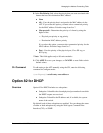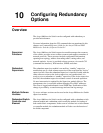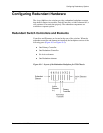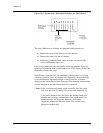
10-2 User Guide for the Avaya P580 and P882 Multiservice Switches, v6.1
Chapter 10
VRRP The Avaya Multiservice Switch supports Virtual Router Redundancy
Protocol (VRRP), an IETF protocol designed to support redundant LAN
routers, as well as load balancing of traffic. VRRP is transparent to host end
stations. All configurations are done at the Avaya Multiservice Switch, no
additional end station configurations are required. See “Configuring
VRRP” in Chapter 12, “Configuring IP Routing,” for more details.
Hunt Groups Ports within a hunt group by default are redundant to one another since hunt
groups perform load balancing among the ports. The hunt group load-shares
the traffic between two switches allowing the bandwidth to be multiplied.
The use of hunt groups also increases reliability since the links behave as
hot standby links to one another. If the traffic is shared over multiple links,
and one of the links is “lost”, the traffic will be automatically redistributed
over the other links and the communications will continue without
interruption. See “Using Hunt Groups to Aggregate Bandwidth” in
Chapter 6, “Using VLANs, Hunt Groups, and VTP Snooping,” for more
details.
Redundant Power
Supplies
Only two power supplies are required to support a fully-loaded Avaya
Multiservice Switch. A third power supply can be installed to provide
backup should one of the other two fail. The power subsystem provides
N+1 power supply redundancy.
Supervisor
Failover
conditions
The Active supervisor module fails over to the standby supervisor if one of
the following events occur:
— Active Supervisor module removal
— Active Supervisor Software reset
— Active Supervisor Module Reset Push button
— Active Supervisor loses power
— Active Supervisor system crash either hardware or software
Chapter Contents The following information and procedures are provided in this chapter:
■ Configuring Redundant Hardware
■ Installing and Enabling Redundant Hardware
■ Replacing the Primary Controller
■ Replacing an Element
■ Configuring Supervisor Module Redundant Ethernet Console IP
Addresses
■ Synchronizing the Active and Standby CPUs


















